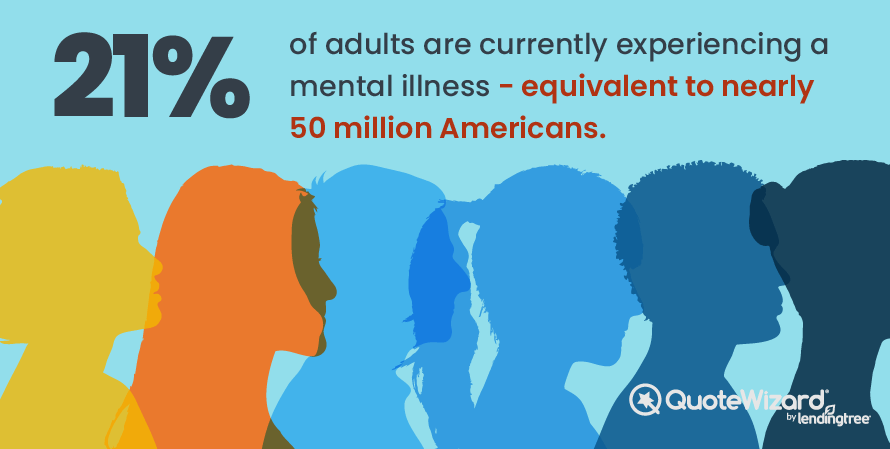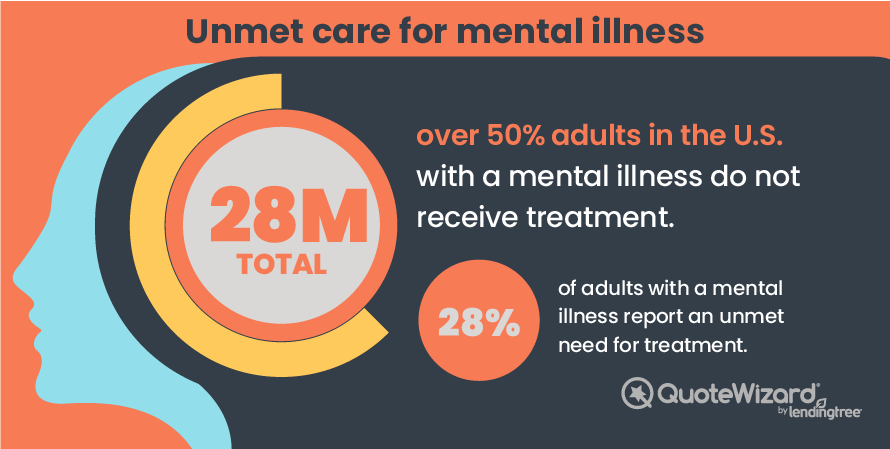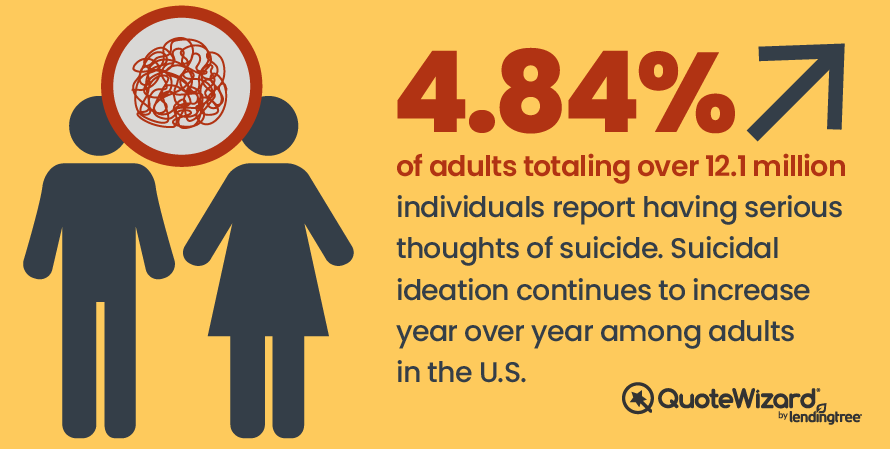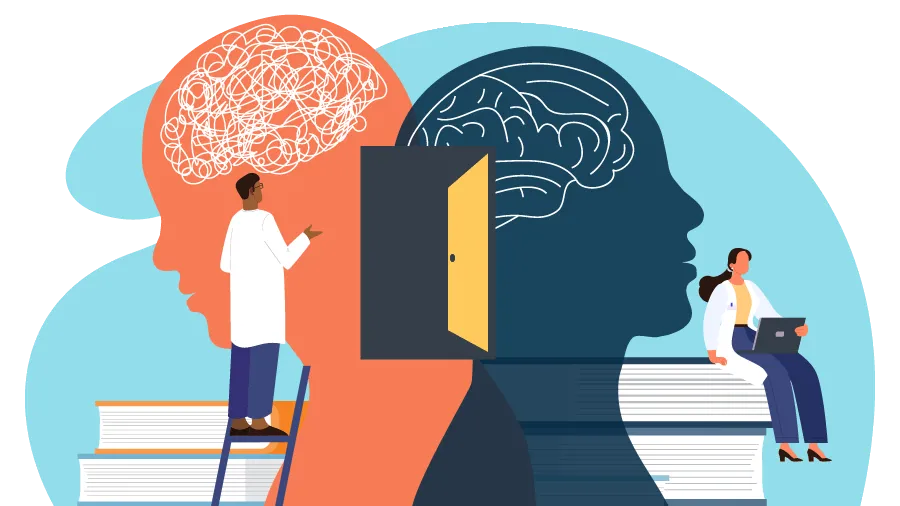Americans are struggling with mental health. Nationwide, more people are taking prescription mental health medication, anxiety and depression levels are rising, suicidal ideation is increasing and 11% of people with a mental illness don’t have insurance.
There are, however, some states that are at the forefront of mental health care. Our team of analysts found that these states have both high access to mental health care and low numbers of people without health insurance.
Key findings:
- Wisconsin, Illinois and Pennsylvania have the best mental health care in the nation.
- Twenty-one percent of Americans have a mental health issue.
- Fifty-five percent of people with a mental illness aren’t receiving care.
- Twenty-eight percent of people with a mental illness experience unmet needs.
To determine the best states for mental health care, our analysts looked at five key factors:
- Prevalence of mental illness in each state
- Access to mental health care
- Percent of those with a mental illness not receiving care
- Percent of those with a mental illness
- Mental illness and health insurance
We found that Wisconsin has the best mental health care in the nation. The state has a high degree of access to care, a low number of uninsured residents with mental health issues and a low number of people with a mental illness who are experiencing unmet needs.
| State | Rank |
|---|---|
| Wisconsin | 1 |
| Illinois | 2 |
| Pennsylvania | 3 |
| Vermont | 4 |
| Massachusetts | 5 |
| Montana | 6 |
| Connecticut | 7 |
| Iowa | 8 |
| New York | 9 |
| Kentucky | 10 |
| Michigan | 11 |
| North Dakota | 12 |
| Rhode Island | 13 |
| Delaware | 14 |
| Washington | 15 |
| Hawaii | 16 |
| South Dakota | 17 |
| Virginia | 18 |
| New Jersey | 19 |
| New Mexico | 20 |
| Maryland | 21 |
| Minnesota | 22 |
| Nebraska | 23 |
| Tennessee | 24 |
| New Hampshire | 25 |
| West Virginia | 26 |
| Maine | 27 |
| South Carolina | 28 |
| California | 29 |
| North Carolina | 30 |
| Alaska | 31 |
| Arkansas | 32 |
| Mississippi | 33 |
| Louisiana | 34 |
| Oklahoma | 35 |
| Utah | 36 |
| Missouri | 37 |
| Ohio | 38 |
| Florida | 39 |
| Colorado | 40 |
| Georgia | 41 |
| Idaho | 42 |
| Nevada | 43 |
| Oregon | 44 |
| Indiana | 45 |
| Wyoming | 46 |
| Texas | 47 |
| Alabama | 48 |
| Kansas | 49 |
| Arizona | 50 |
| Source: Mental Health America | |
Mental illness is incredibly common in the U.S. One in five adults currently experiences a mental illness.

Many of these illnesses are left untreated. Over half of people with a mental health illness do not receive treatment, and 28% experience unmet needs.

The consequences for this lack of treatment cannot be overstated. Suicide rates are up 30% since 1999, and more than 90% of people who commit suicide show symptoms of mental health issues.

Understanding mental health coverage
Insurance is a major factor when it comes to receiving mental health care. We found a direct correlation between the number of people who don't receive mental health care and the number of people who have a mental illness but do not have insurance. Texas, for example, has the third-worst overall access to care and the second-highest percentage of people without insurance.
Having insurance is key because under the Affordable Care Act, most health insurance plans must also include coverage for mental health services and substance abuse.
| State | % with a mental illness | % with mental illness not receiving care | % with mental illness with unmet needs | % with mental illness without insurance |
|---|---|---|---|---|
| Alabama | 21% | 62% | 35% | 18% |
| Alaska | 22% | 55% | 30% | 7% |
| Arizona | 24% | 64% | 36% | 15% |
| Arkansas | 23% | 46% | 29% | 12% |
| California | 20% | 63% | 28% | 8% |
| Colorado | 23% | 56% | 34% | 10% |
| Connecticut | 19% | 56% | 27% | 6% |
| Delaware | 21% | 48% | 31% | 8% |
| Florida | 17% | 58% | 29% | 14% |
| Georgia | 18% | 58% | 29% | 17% |
| Hawaii | 18% | 69% | 20% | 7% |
| Idaho | 25% | 52% | 32% | 12% |
| Illinois | 21% | 51% | 26% | 6% |
| Indiana | 22% | 51% | 39% | 14% |
| Iowa | 21% | 47% | 25% | 9% |
| Kansas | 26% | 52% | 36% | 18% |
| Kentucky | 22% | 52% | 23% | 5% |
| Louisiana | 21% | 53% | 29% | 11% |
| Maine | 22% | 54% | 27% | 14% |
| Maryland | 18% | 55% | 33% | 7% |
| Massachusetts | 21% | 43% | 31% | 5% |
| Michigan | 22% | 49% | 26% | 7% |
| Minnesota | 23% | 50% | 27% | 12% |
| Mississippi | 21% | 56% | 25% | 13% |
| Missouri | 21% | 50% | 30% | 17% |
| Montana | 23% | 41% | 25% | 8% |
| Nebraska | 23% | 42% | 23% | 16% |
| Nevada | 21% | 61% | 38% | 10% |
| New Hampshire | 24% | 49% | 27% | 13% |
| New Jersey | 18% | 56% | 23% | 13% |
| New Mexico | 21% | 46% | 33% | 10% |
| New York | 19% | 58% | 24% | 6% |
| North Carolina | 20% | 51% | 26% | 16% |
| North Dakota | 21% | 48% | 28% | 8% |
| Ohio | 24% | 56% | 28% | 10% |
| Oklahoma | 26% | 54% | 26% | 12% |
| Oregon | 27% | 54% | 33% | 10% |
| Pennsylvania | 20% | 52% | 25% | 7% |
| Rhode Island | 24% | 50% | 28% | 4% |
| South Carolina | 22% | 51% | 21% | 13% |
| South Dakota | 21% | 46% | 27% | 14% |
| Tennessee | 20% | 46% | 31% | 9% |
| Texas | 18% | 62% | 30% | 21% |
| Utah | 30% | 50% | 34% | 8% |
| Vermont | 24% | 43% | 27% | 6% |
| Virginia | 21% | 47% | 32% | 7% |
| Washington | 26% | 50% | 22% | 7% |
| West Virginia | 26% | 51% | 18% | 10% |
| Wisconsin | 22% | 47% | 21% | 6% |
| Wyoming | 24% | 54% | 27% | 25% |
| United States | 21% | 55% | 28% | 11% |
| Source: Mental Health America | ||||
Mental Health Resources
National Institute of Mental Health (NIMH)
- 1 (866) 615-6464
- NIMH website
Substance Abuse and Mental Health Services Administration (SAMHSA)
- 1 (800) 662-4357 (24 hours)
- SAMHSA website
National Alliance on Mental Illness
- 1 (800) 950-6264
- info@nami.org
Methodology
States were evaluated based on data from Mental Health America. Overall rankings were determined by a composite score based on access to care, insurance rates and the prevalence of mental illness in each state.
References:
QuoteWizard.com LLC has made every effort to ensure that the information on this site is correct, but we cannot guarantee that it is free of inaccuracies, errors, or omissions. All content and services provided on or through this site are provided "as is" and "as available" for use. QuoteWizard.com LLC makes no representations or warranties of any kind, express or implied, as to the operation of this site or to the information, content, materials, or products included on this site. You expressly agree that your use of this site is at your sole risk.
